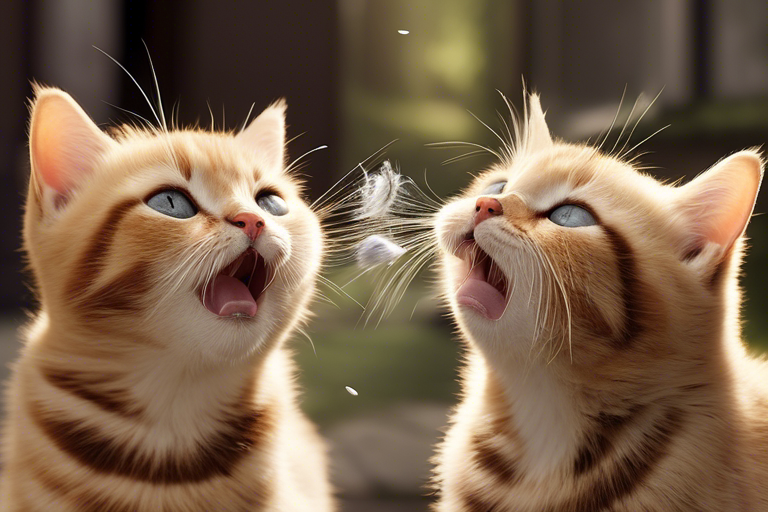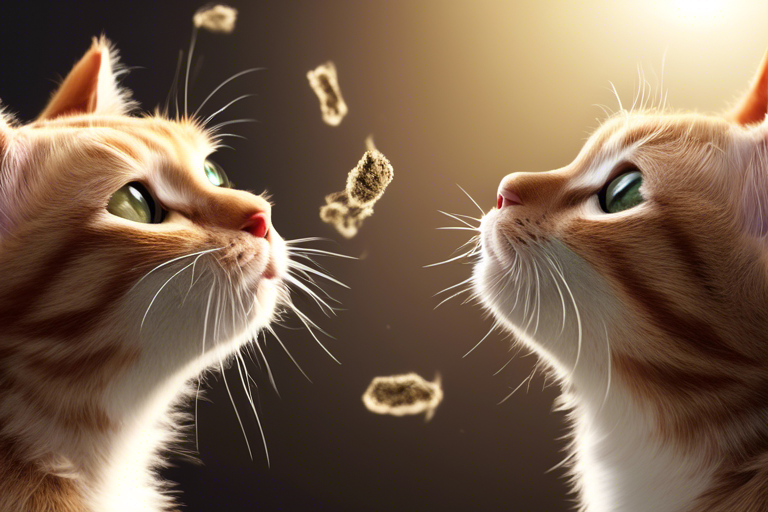Cats are fascinating creatures with a multitude of unique behaviors and mannerisms that often leave us perplexed. One such behavior that cat owners may have observed is cats blowing air out of their noses. At first glance, it may appear similar to sneezing, but there is more to it than meets the eye. In this comprehensive guide, we will delve into the reasons behind this peculiar behavior and shed light on what it means when your cat exhibits this behavior.
Understanding Feline Respiratory System
To grasp why cats blow air out of their noses, it is essential to understand how their respiratory system functions. Like other mammals, cats have a pair of lungs that take in oxygen and expel carbon dioxide. However, their respiratory process differs from humans and is more efficient. Cats possess a unique method of breathing called “non-uniform lung ventilation,” enabling air to flow through their lungs in a non-uniform manner, facilitating greater oxygen uptake. Additionally, cats have a superior sense of smell closely linked to their respiratory system.
The Anatomy of a Cat’s Nose
Cats have a highly developed sense of smell, and their nose plays a crucial role in this aspect. The feline nose differs significantly from that of humans, characterized by a unique structure consisting of two nostrils separated by a thin septum. Within this structure, the cat’s nose contains bony plates that aid in filtering out impurities from the air. Moreover, their nasal cavity houses specialized cells called olfactory receptors, which detect and distinguish different scents.
The nasal cavity is also lined with mucus, which serves to trap foreign particles like dust, pollen, and bacteria. The mucus is either expelled through the nose or swallowed and broken down by stomach acid. This explains why cats may sometimes have a runny nose or sneeze, as their bodies attempt to eliminate these irritants.
How Cats Breathe: The Process
Cats primarily breathe through their nose, although they are also capable of mouth breathing. The breathing process begins with the inhalation of air through their nose or mouth, which then travels down their trachea and into their lungs. Once oxygen is absorbed in the lungs, it is exchanged with carbon dioxide, which is subsequently expelled from the body through exhalation.
It is worth noting that cats have a higher respiratory rate compared to humans, meaning they breathe faster. This is due to their smaller lung capacity, necessitating more breaths to obtain the same amount of oxygen. Additionally, cats are obligate nasal breathers, relying heavily on their noses for breathing and finding it more challenging to switch to mouth breathing compared to humans.

Common Respiratory Issues in Cats
As with any living creature, cats can develop respiratory issues. One prevalent problem is feline asthma, characterized by inflammation and narrowing of the airways, making it difficult for cats to breathe. Symptoms of feline asthma include coughing, wheezing, and difficulty breathing. Another common respiratory issue is upper respiratory infections, often caused by viruses like feline herpesvirus or calicivirus. Symptoms of an upper respiratory infection include sneezing, a runny nose, and watery eyes.
Understanding the intricacies of a cat’s respiratory system can help us provide better care for our feline friends. From their unique breathing method to their highly developed sense of smell, cats are truly captivating creatures with much to discover.
Reasons Behind Cats Blowing Air Out of Their Noses
Cats exhibit a myriad of behaviors that can leave us intrigued, and blowing air out of their noses is one such behavior. While it may seem like a simple act, there are several reasons behind this behavior. Let’s explore them below:
Clearing Their Nasal Passages
One possible reason for cats blowing air out of their noses is to clear their nasal passages. Cats are naturally curious creatures and love to explore their surroundings. However, this curiosity can sometimes lead them to encounter strong smells, dust, or other irritants that cause nasal congestion. By blowing air out of their nose, cats can effectively clear any obstructions and maintain proper airflow, essential for their respiratory health.
Cooling Themselves Down
Cats are renowned for their affinity for warmth and can often be found basking in sunny spots around the house. However, when temperatures rise, cats may need to find ways to cool themselves down. Blowing air out of their noses and mouths is one such behavior. This act helps them release excess body heat, aiding in regulating their body temperature.
Expressing Emotions or Stress
Cats are complex creatures with a wide range of emotions. They can display excitement, surprise, fear, and stress in various ways. Blowing air out of their noses is one way cats express their emotions. They may puff out air sharply to show excitement or surprise or blow air out of their noses as a way to release tension in stressful situations.
Scent Detection and Communication
Cats heavily rely on their sense of smell and utilize their noses to detect the presence of other animals in their territory. Blowing air out of their noses can also serve as a way of dispersing scent and marking their territory. Male cats, in particular, exhibit this behavior to communicate with other cats and establish dominance.
Understanding the reasons behind cats blowing air out of their noses can help us gain insight into their behaviors and provide them with the care they need to live happy and healthy lives.
How to Identify Normal vs. Abnormal Cat Breathing
As responsible cat owners, it is crucial to understand what constitutes normal breathing for our feline companions. Not only does this knowledge enable us to keep our cats healthy and content, but it also allows us to identify potential medical issues that may require attention. In this section, we will discuss the signs of healthy breathing in cats and highlight respiratory issues that may necessitate medical intervention.
Signs of Healthy Breathing in Cats
Healthy breathing in cats is characterized by a regular, smooth rhythm with gradual inhalation and exhalation. The cat’s chest should expand and contract evenly, without any audible sounds or wheezing. Additionally, you may notice a slight increase in breathing rate when your cat is excited or engaging in physical activity, but it should return to a normal rate during rest.
It is essential to pay attention to your cat’s overall behavior and activity level. If your cat is eating, drinking, and playing normally, it is a good indication that their breathing is healthy.
Indications of Respiratory Issues
If you observe any of the following symptoms, it may be indicative of respiratory problems in your cat:
- Labored breathing: If your cat appears to be breathing heavily or struggling to catch their breath, it could be a sign of a respiratory issue.
- Rapid or shallow breaths: Cats typically take between 20-30 breaths per minute. If you notice your cat breathing faster than this or taking shallow breaths, it could be a cause for concern.
- Coughing: Although cats do not cough as frequently as dogs, persistent or frequent coughing can indicate respiratory issues. If your cat is coughing or has a persistent cough, it is best to consult a veterinarian.
- Wheezing: Wheezing is a high-pitched whistling sound that occurs when air flows through narrowed airways. If you notice your cat wheezing, it could be a sign of asthma or other respiratory problems.
- Discharge from the nose or mouth: If your cat has discharge from their nose or mouth, it could be a sign of an infection or another respiratory issue.
If you observe any of these signs in your cat, it is essential to seek immediate medical attention. Respiratory problems can be life-threatening if left untreated.

When to Consult a Veterinarian
If you notice any unusual behavior or symptoms in your cat, it is best to consult a veterinarian. Respiratory issues in cats can arise due to various reasons, including allergies, infections, tumors, or blockages. Only a professional veterinarian can accurately diagnose and provide appropriate treatment for your cat.
Additionally, if your cat has a pre-existing condition such as asthma or heart disease, it is crucial to closely monitor their breathing and consult a veterinarian if you notice any changes or abnormalities.
Remember, as a cat owner, you play a vital role in maintaining your pet’s health and well-being. By understanding what constitutes normal breathing and being aware of potential respiratory issues, you can help ensure that your cat lives a happy and healthy life.
Other Unique Feline Behaviors Explained
Cats exhibit a wide range of behaviors that can sometimes leave us puzzled. Let’s take a look at some other unique behaviors of cats and unravel their meanings.
Kneading with Their Paws
Kneading is a common behavior in which cats push in and out with their paws, typically on soft surfaces like blankets or pillows. This behavior is believed to be derived from their kittenhood, when they kneaded their mother’s belly to stimulate milk production. As adults, cats may knead to express contentment, relaxation, or as a way to mark their territory using scent glands located in their paws.
Interestingly, some cats may also knead as a form of self-soothing when they feel anxious or stressed. This behavior can help them calm down and feel more secure.
Chattering at Birds
When cats spot birds through a window or outdoors, they often make a chattering sound. This behavior is thought to be related to their natural hunting instincts and may mimic the sound they make when catching prey.
Some experts suggest that this behavior could also be a form of frustration. Cats may make this sound when they are unable to hunt the birds, expressing their disappointment.
Slow Blinking as a Sign of Affection
Cats often engage in slow blinking, also known as “cat kisses,” when interacting with their owners or other cats. This behavior is a sign of affection and trust. Slow blinking is a way for cats to communicate calmness and relaxation and can also be used as a sign of submission in social situations.
Some cat owners have even learned to slow blink back at their cats, strengthening the bond between them. It is a great way to communicate with your furry friend and show them that you understand their feelings.
In conclusion, cats blowing air out of their noses is a common and natural behavior with various underlying reasons. By understanding and appreciating these behaviors, we can deepen our understanding of our feline friends and provide them with the care they need to thrive.







2 thoughts on “Cats Blowing Air Out of Their Noses: Exploring the Peculiar Behavior”